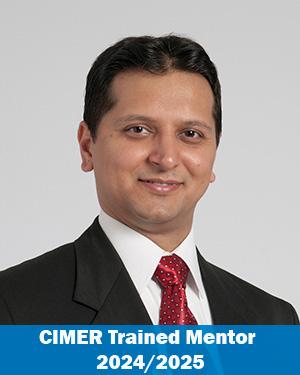Vijay Krishna Laboratory
-
Vijay Krishna Laboratory
- Principal Investigator
- Research
- Our Team
- Publications
- Careers
- Research News
Research
Our lab is developing next-generation nanotechnology-based solutions for various healthcare challenges. We believe in proactive healthcare preventing future patients. The major research projects include 1) safe and effective UV absorbers for preventing skin cancers and melanoma; 2) enzyme-mimicking nanomaterials for extending healthspan; 3) novel metallic nanocomposites for antimicrobial coatings on devices; 4) nanoparticle-based minimally-invasive approach for kidney stone treatment; 5) non-invasive tumor destruction with photonic nanomaterials for in situ cancer vaccination; and 6) photocatalytic antimicrobial agents to prevent transmission of infection from surfaces;. Our lab also uses computational chemistry on high-performance computer and quantum computer to understand the light-molecule interactions and catalysis.
Biography
Education & Professional Highlights
"CIMER Trained Mentor" indicates the principal investigator has completed mentorship training based on curriculum from the Center for the Improvement of Mentored Experiences in Research, aimed at advancing mentoring relationships and promoting cultural change in research.
Research
UV Absorbers
UV Absorbers to Prevent Skin Cancer and Melanoma
Over one million new cases of skin cancer are diagnosed annually in the U.S., outnumbering the total number of all other cancer diagnoses combined. Exposure to UV is the most common cause, and the most preventable, for skin cancers. Application of sunscreens is routinely recommended by dermatologists for preventing skin cancers. However, current sunscreens are designed to prevent sunburn (an immune response to UV damage) and not necessarily block UV completely to prevent skin cancers.
We have developed polyhydroxy fullerenes (water-soluble inorganic carbon-based molecules, PhotoSorb) as multifunctional UV absorber that is stable and safe. Currently, we are engineering carbon nanomaterials (carbon nanotubes and graphene) that are broad-spectrum UV absorbers and safe for humans and the environment. Our novel UV absorbers can safely replace the multiple active ingredients in current sunscreens and skincare products for preventing skin cancers and melanoma.
Current Team Members: Tram Phan, Yang Yang, Hope Zehr
Collaborators: Edward Maytin
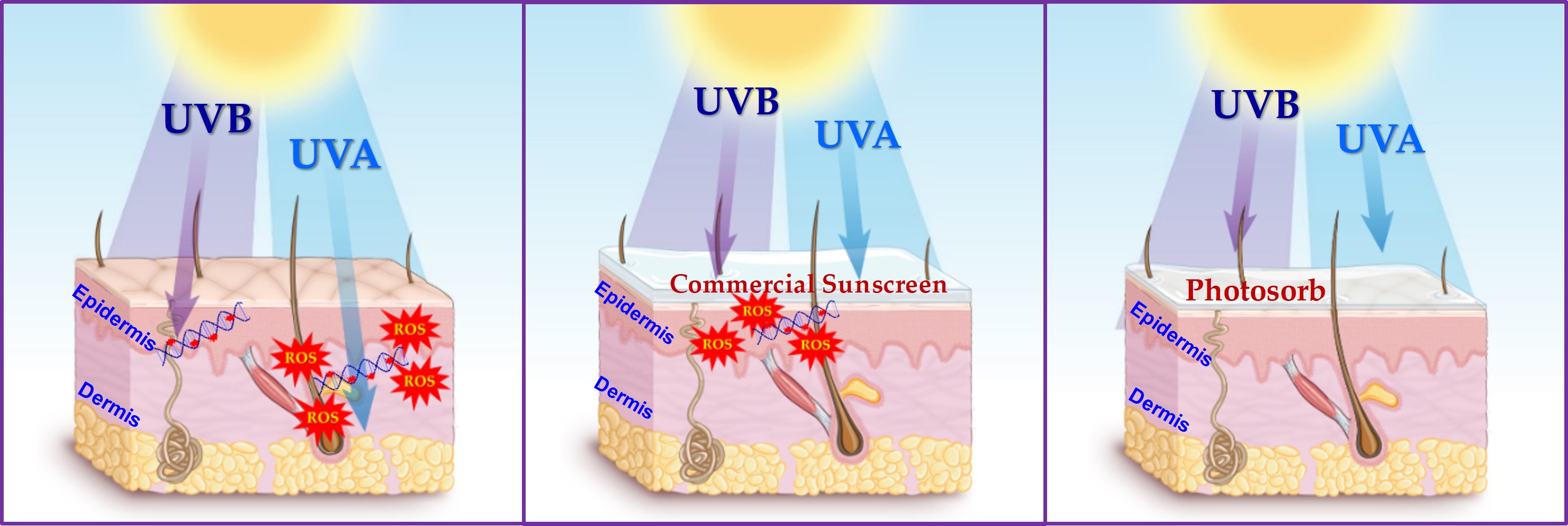
Nanozymes
Enzyme-Mimicking Nanomaterials for Healthspan Extension
Enzymes are catalytic proteins that pace every cellular function and play a crucial role in maintaining homeostasis and fighting diseases. A common hallmark of aging is the decline in metabolic enzyme functions due to genetic, epigenetic or post-translational modifications. Aging increases risk for cardiovascular, metabolic and neurologic diseases. Devising innovative, effective, and efficient strategies that rescue deficiencies in metabolic enzymes has the potential extend healthspan.
We are designing carbon-sulfur lyase mimicking nanomaterials to rescue decline in metabolic enzyme function. The first generation of enzyme mimics are currently being evaluated for lifespan extension in mice.
Current Team Members: Alan Chen, Veebha Havaldar, Yang Yang
Collaborators: Christopher Hine, Joshua Arbesman, Luciana Hannibal
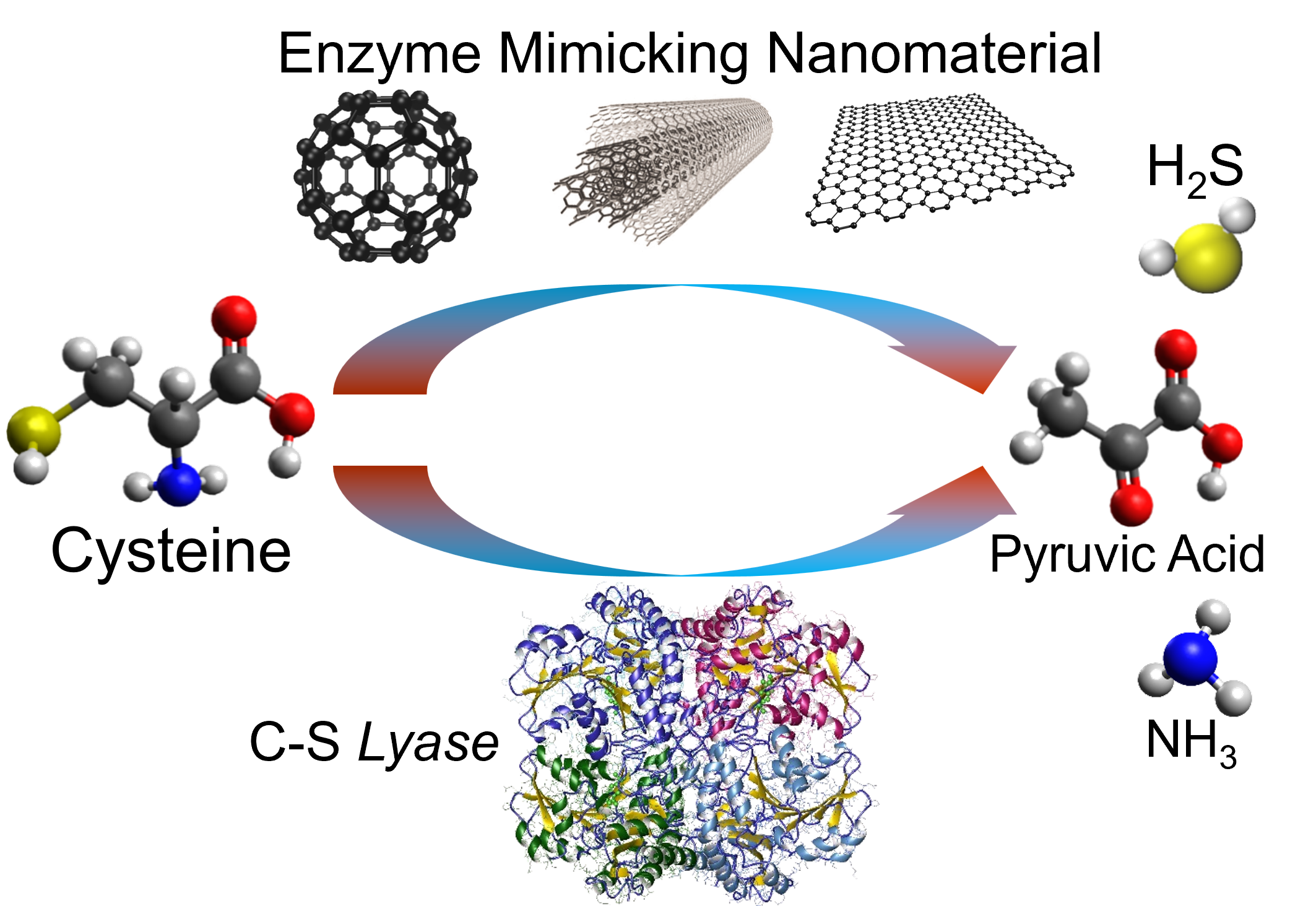
C60-Metal
Novel Fullerene-Metal Nanocomposites
Fullerenes and metal nanoparticles have unique physicochemical properties that are attractive, and several attempts have been made to combine them. However, most of the composites created thus far have a binding linker that prevents direct contact of fullerene cage with the metal nanoparticles.
We have developed a novel method of creating fullerene-metal nanocomposites using polyoxy fullerenes as a single reducing and capping agent. This facile synthesis method can be used to create metal nanoparticles of different sizes varying from 1–100 nm. Further, this method enables synthesis of multi-metallic nanocomposites. We are exploring different properties of these novel fullerene-metal nanocomposites. Fullerenes enhances the antimicrobial activity of silver nanoparticles.
Current Team Members: Yue Xu
Collaborators: Aaron Miller
Photonic Lithotripsy
Photonic Nanomaterials for Kidney Stone Treatment
Kidney stones are increasingly prevalent, with 1 in 9 individuals being affected in the U.S., and the prevalence expected to increase to 13% by 2030. Kidney stones are mineral-based precipitates that develop in the collecting system (pelvis and calyces) of the kidney and are associated with crippling pain, severe infection, kidney damage, and even death. The most common stone treatments include laser lithotripsy by ureteroscopy, and extracorporeal shock wave lithotripsy.
We are developing photonic lithotripsy, which utilizes carbon or metal based photonic nanomaterials and deep-tissue penetrating near-infrared laser operating at wavelengths of minimum water absorption. Our publication is the first report of using photonic nanomaterials for hard tissue disintegration. Photonic lithotripsy has the potential to transform kidney stone treatment as a safe and non-invasive alternative.
Current Team Members: Ian Houlihan
Collaborators: Smita De
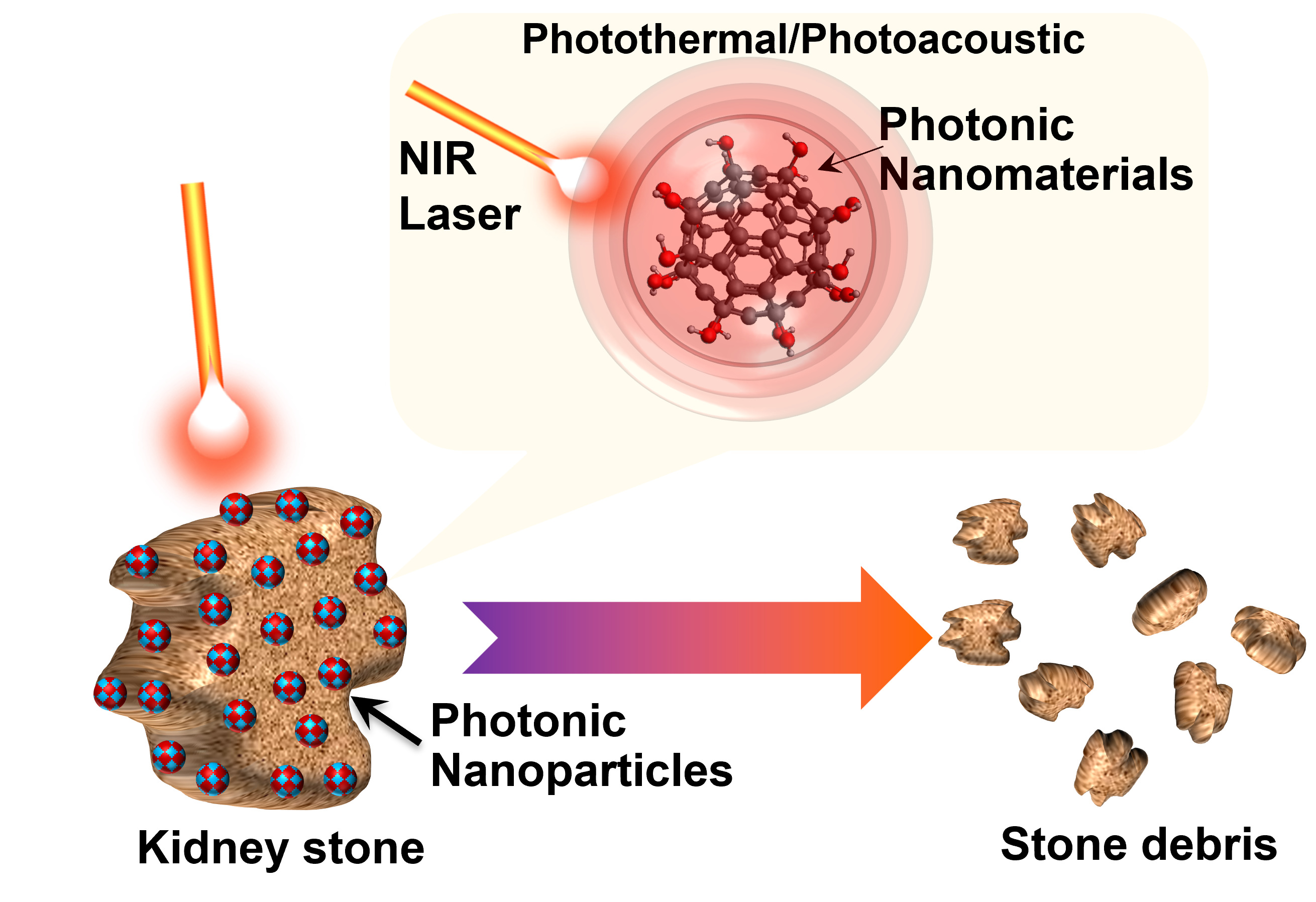
Quantum Computing
Quantum Computing for Photon-Molecule Interactions in Photodynamic Therapy
Understanding photon-drug interactions and excited state dynamics is necessary for the design and selection of drug molecules that, depending on their application scope, either maximizes interaction (excited electron transfer), such as photodynamic therapy (cancer treatment) and photocatalysis (antimicrobial for disease prevention), or minimizes interaction, such as in sunscreens (cancer prevention), photonic treatment (cancer and kidney stones) and contrast agents (imaging). The excited state dynamics depend not only on the structure of the molecules, but also on the incident photon frequencies. Engineered photon-drug interactions thus hold great potential for many healthcare applications, but designing these interactions poses significant computational challenges.
Currently, quantum chemical computations are conducted on high-performance computing clusters using conventional quantum-chemistry software packages to optimize molecular geometry and calculate excited state and vibrational energies. A major drawback of using classical computers for these calculations is the exponential increase in computation time with the number of atoms, necessitating further approximations, which often produce unreliable results. We are collaborating with Algorithmiq and IBM on developing next generation quantum computing algorithms for Cleveland Clinic IBM Quantum System One to predict with high accuracy the excited state dynamics of large molecules with strong correlation, thereby accelerating the discovery and optimization of novel photosensitizers.
Current Team Members: Hope Zehr
Collaborators: Algorithmiq, IBM Zurich
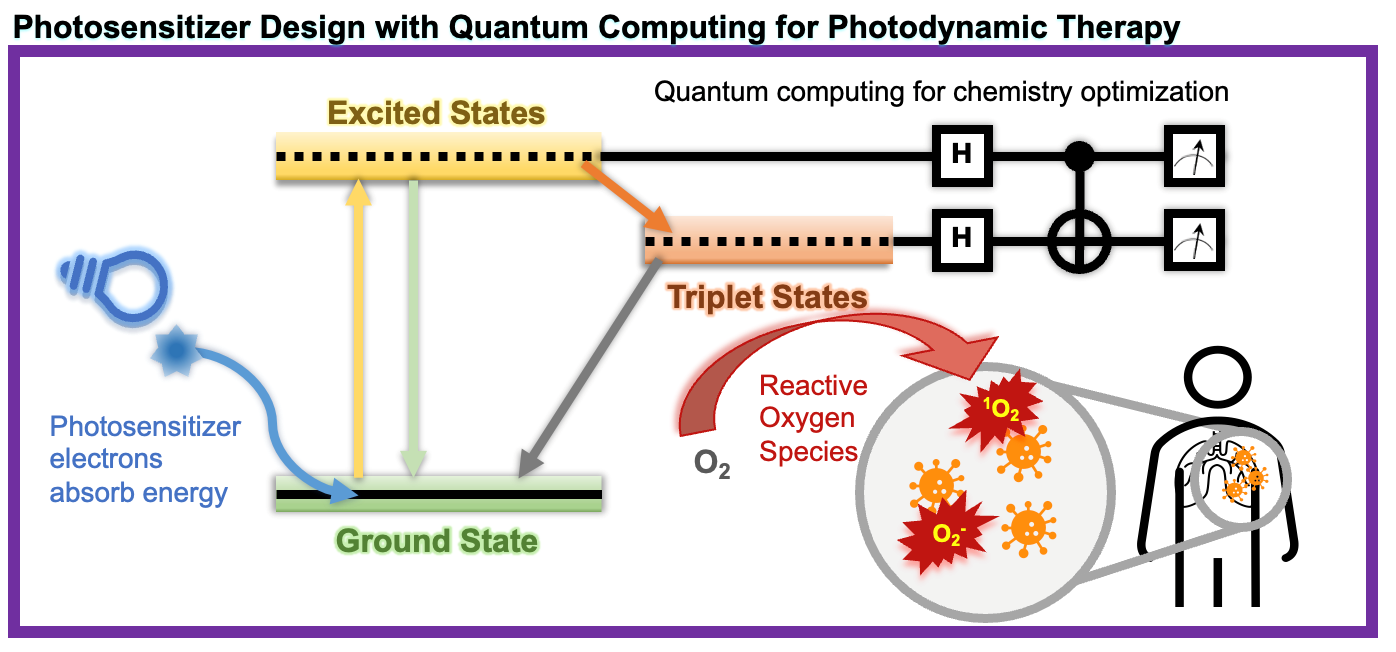
PhotoProtect
Visible Light Active Photocatalytic Antimicrobial Coatings to Prevent Disease Transmission
Surfaces are repositories of viruses, bacteria and fungi, and a major mode of disease transmission causing infections, allergy and respiratory problems. Cleaning of the surfaces is not sufficient to eliminate the risk of infection. Common alcohol or hypochlorite disinfectants are ineffective against bacteria and fungi. Antibiotic-resistant pathogens are not limited to healthcare settings, and outbreak of multidrug-resistant emerging fungus Candida auris is increasing. Surfaces must be made antimicrobial to limit disease transmission.
We have developed visible light active, transparent antimicrobial coatings that not only kills, but also degrades viruses, bacteria, fungi and spores. The antimicrobial was formulated in a simple water-based formulation that can be easily spray coated on all surfaces. In a beta facility testing, antimicrobial coatings rapidly decreased surface bacterial level and maintained benign surfaces for at least one year. Most importantly, healthcare-acquired infection was reduced by more than 50%.
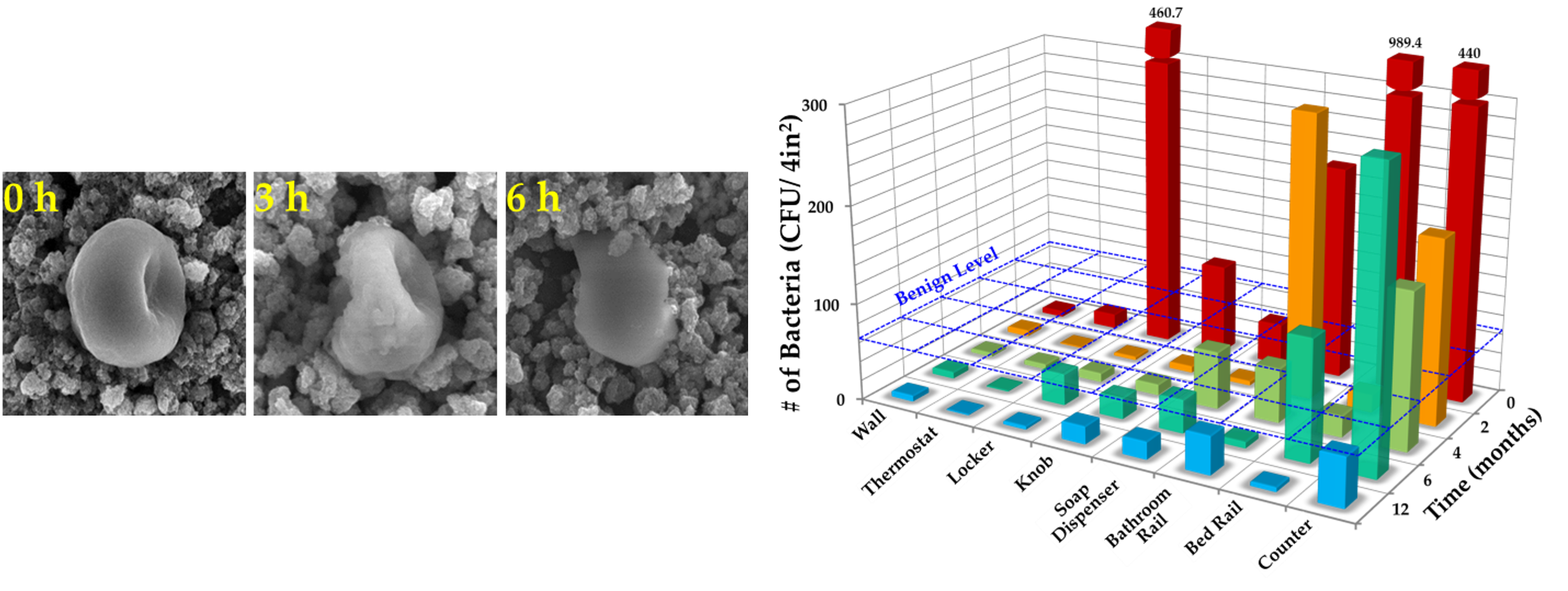
Our Team
Selected Publications
View publications for Vijay Krishna, PhD
(Disclaimer: This search is powered by PubMed, a service of the U.S. National Library of Medicine. PubMed is a third-party website with no affiliation with Cleveland Clinic.)
Peer reviewed journals
(* indicates Corresponding author)
- Nykänen, A., Thiessen, L., Borrelli, E., Krishna, V., Knecht, S., and *Pavošević, F., “Toward accurate calculation of excitation energies on quantum computers with ΔADAPT-VQE: A case study of BODIPY derivatives,” Journal of Physical Chemistry Letters, 7111–7117, 2024.
- Houlihan, I., Kang, B., *Krishna, V., and *De, S., “Proof-of-concept for a novel nanotechnology-based treatment for urolithiasis,” Urolithiasis, 52, 60, 2024. PMC10998784
- Houlihan, I., Kang, B., De, S., and *Krishna, V., “Photonic lithotripsy: Near-infrared laser activated nanomaterials for kidney stone comminution,” Nano Letters, 23 (13), 5981, 2023. PMC10348310
- Mahen, K., Markley, L., Bogart, J., Klatka, H., Krishna, V., Maytin, E., Stark, G., and *McDonald, C., “Topical N‐phosphonacetyl‐l‐aspartate is a dual action candidate for treating non‐melanoma skin cancer,” Experimental Dermatology, 1–13, 2023. PMC10527533
- Mulay, P., Chen, C., and *Krishna, V., “Enzyme-independent catabolism of cysteine with pyridoxal-5’-phosphate,” Scientific Reports, 13 (1), 312, 2023. PMC9822980
- Palomina, L., Haro, D., Gakiya-Teruya, M., Zhou, F., Rosa-Toro, A., Krishna, V., and *Rodriguez-Reyes, J., “Polyhydroxy fullerenes enhance antibacterial and electrocatalytic activity of silver nanoparticles,” Nanomaterials, 12 (19), 3321, 2022. PMC9565599
- Chen, A., Grobmyer, S., and *Krishna, V., “Photothermal response of polyhydroxy fullerenes,” ACS Omega, 5 (24), 14444-14450, 2020. PMC7315565
- Gakiya-Teruya, M., Palomino-Marcelo, L., Pierce, S., Angeles-Boza, A., Krishna, V., and *Rodriguez-Reyes, J-C., “Enhanced antimicrobial activity of silver nanoparticles conjugated with synthetic peptide by click chemistry,” Journal of Nanoparticle Research, 22 (90), 2020.
- *Indeglia, P., Georgieva, A, Krishna, V., Martyniuk, C., and Bonzongo, J-C., “Toxicity of functionalized fullerene and fullerene synthesis chemicals,” Chemosphere, 207, 1–9, 2018.
- *Krishna, V., Bai, W., Han, Z., Yano, A., Thakur, A., Georgieva, A., Tolley, K., Navarro, J., Koopman, B., and Moudgil, B., “Contaminant-activated visible light photocatalysis,” Scientific Reports, 8, 1894, 2018. PMC5789862
- *Krishna, V., Zhao, J., Koopman, B., and Moudgil, B., “Purification procedure sensitizes Bacillus endospores to free radicals from UVA radiation and photocatalysis,” International Journal of Astrobiology, 1–7, 2017.
- Nandakumar, V., Han, Z., Fritz, Z., Krishna, V., Koopman, B., and *Moudgil, B., “Visible light photocatalytic bacterial inactivation on titanium dioxide coatings,” KONA Powder and Particle Journal, 34, 234–240, 2017.
Other publications
(* indicates Corresponding author)
- Xu, Y., Stella, M., Knecht, S., Pavosevic, F., and *Krishna, V., “Polyhydroxy fullerene, fullerol, fullernol or polyoxy fullerenes? A combined experimental and theoretical interrogation,” ChemRxiv, 2024.
- Nykänen, A., Thiessen, L., Borrelli, E., Krishna, V., Knecht, S., and *Pavošević, F., “ΔADAPT-VQE: Toward accurate calculation of excitation energies on quantum computers for BODIPY molecules with application in photodynamic therapy,” Arxiv, arXiv:2404.16149, 2024.
- Rodriguez-Alvarez, J-S., Xu, Y., Gutierrez-Aceves, J., De, S., Miller, A., and Krishna, V., “Novel nanoparticle coatings demonstrate antibacterial and antibiofilm properties against multiple uropathogens,” Journal of Urology, 211(5S), e701, 2024.
- Houlihan, I., Pandey, A., De, S., and Krishna, V., “Effect of stone-targeting nanomaterials on fragment size using photonic lithotripsy,” Journal of Urology, 211(5S), e483, 2024.
- Houlihan, I., Kang, B., De, S., and Krishna, V., “Photonic lithotripsy: Effect of gold and carbon based nanomaterials on stone comminution,” Journal of Urology, 209(S4), e49, 2023.
- Mulay, P., Chen, C., and *Krishna, V., “Enzyme-independent interaction of pyridoxal-5’-phosphate with cysteine,” ChemRxiv, 2022.
- Houlihan, I., Mulay, P., De, S., and Krishna, V., “Delineating the failure mechanism for photonic lithotripsy,” Journal of Urology, 207(S5), e1043–e1044, 2022.
- Mulay, P., De, S., and Krishna, V., “Photonic nanoparticles for photoacoustic lithotripsy,” Journal of Urology, 206(S3), e1173–e1174, 2021.
Careers
We are looking for highly motivated and enthusiastic undergraduate students for research training on different projects.
Training at Lerner Research Institute
Our education and training programs offer hands-on experience at one of the nationʼs top hospitals. Travel, publish in high impact journals and collaborate with investigators to solve real-world biomedical research questions.
Learn MoreResearch News

Unlike other UV blockers, Photosorb is a single, multifunctional ingredient that is safe to use at high concentrations, offering enhanced skin cancer protection in sunscreens.

Through the Discovery Accelerator partnership, IBM and Cleveland Clinic teams will collaborate closely on one project, and with Algorithmiq on a second project.

A new study led by Vijay Krishna, PhD, Lerner Research Institute Department of Biomedical Engineering, created a solution to hospital-acquired infections by studying a chemical compound that when exposed to visible light, can effectively degrade organic surface contaminants.
